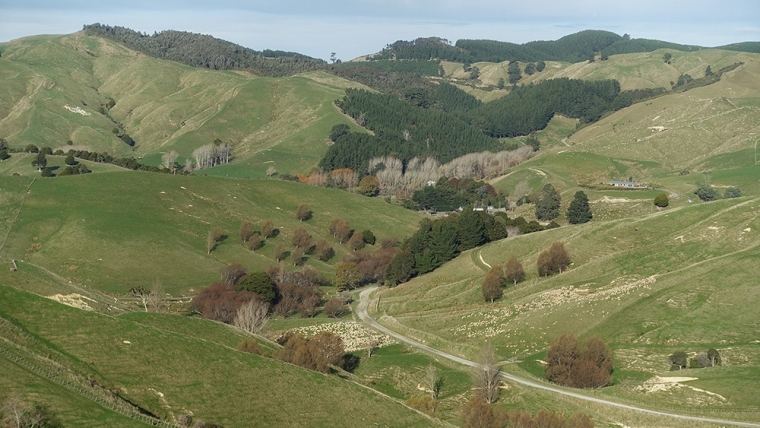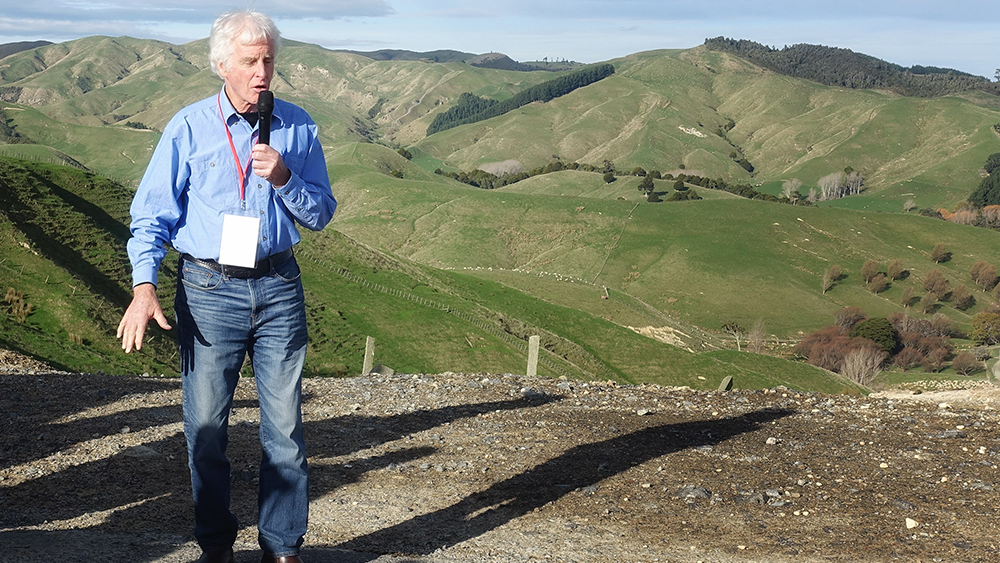
Some weeks back I wrote an article on New Zealand’s sheep and beef farms, focusing on the current situation. I said I would be back as there was more to discuss about both the present and the future. Here, I want to focus more specifically on the North Island hill country (Beef+Lamb Class 4) and hard-hill country (Class 3). These land classes comprise around 4000 farms and contain approximately 45 percent of New Zealand’s commercial sheep and beef farms.
Before heading further down that track, I want to share some information supplied by Rob Davison from Beef+Lamb. The 2017 Statistics Department national census indicates there are approximately 26,400 sheep and beef farms in New Zealand. However, Beef+Lamb estimates that only 9200, or 35 percent thereof, are commercial farms. These commercial farms typically have at least 750 stock units and comprise 97 percent of New Zealand’s sheep production plus 88 percent of the beef cattle production. That means there are another 17,200 lifestyle and hobby farmers.
Although the 17,200 non-commercial farmers may not be particularly important from a production perspective, they are still a very important part of the rural community. Many of these people have a day-job in the agricultural servicing industry.
Beef+Lamb put out a fact sheet in June 2020 looking at hill-country farming. They reckoned there were 920 Class 3 North Island hard-hill farms totalling 1.08 million effective hectares, and there were 3055 Class 4 hill farms on somewhat gentler country totalling 1.8 million effective hectares. The total area was 2.9 million ha of combined Class 3 and 4 hill country compared to 3.8 million in 1991. So where did the 900,000 ha of North Island pastoral farming disappear to?
Precise details are not clear, but the biggest contributor to that loss of hill-country pastoral land seems to have has been scrub reversion. This was land that was simply too difficult to farm. Another contributor was forestry.
Over this period the total New Zealand increase of forestry land was 379,000 ha and some of this was in the South Island. So, it seems that scrub reversion has to be the biggest contributor to pastoral land-loss in the North Island hill country. It wasn’t dairy, it wasn’t horticulture, and it wasn’t urban sprawl. None of these were of significant relevance on these hills.
A third contributor has been voluntary QE2 covenants into conservation land. This is something the urban community does not always recognise.
These North Island hill farms not only comprise about 45 percent of New Zealand’s sheep and beef farms, they also comprise about 45 percent of New Zealand’s commercial sheep and beef farm area and carry around 45 percent of New Zealand’s sheep and beef stock units. This consistent number of ‘45 percent’ is coincidental and just the way it happens to balance out, with the total New Zealand sheep and beef industry including much more extensive South Island tussock country plus intensive properties across both islands on easier country. A big question is what will these farms look like in another 30 years?
This last weekend I had the pleasure of attending the biennial conference of Nuffield scholarship alumni as an external speaker. The big topic we were addressing was what will New Zealand agriculture look like in another 30 years and how do we make the necessary transitions. Sheep farming was one part of that story.
But first a little on the ‘Nuffields’. Each year since 1950, Nuffield scholarships have been awarded for Kiwi farmers to travel the world for around four months researching a topic of importance to New Zealand agriculture. Prior to 2013, in most years there were two scholars and since then each year there have been five. The scholarships go to people who in the opinion of the trustees have potential to take up leadership roles in the rural community. Most scholars are between 35 and 45 but age is not fixed. Anyone can apply regardless of qualifications. It is all about leadership potential.
At this year’ s conference, the alumni spanned from 1968 through to the current bunch for 2021. Alas, those from pre-1968 have almost all now left us. This year the alumni met in Masterton including a visit to Derek and Chris Daniell’s ‘Wairere’ property. Derek was one of the Nuffield scholars from 1991.
Those of my readers who are themselves sheep farmers will recognise Wairere as a major source of rams across New Zealand’s hill country, with some 3000 rams sold every year. The Wairere philosophy is that tough hill country is the right place to rear resilient rams for other hill-country properties, and Derek has done this with a strong performance-based science-led approach. The Wairere rams are also exported to Australia, the UK and South America.
The big message that I took from our visit to Wairere is that even on hard-hill country it is possible to get great performance with the right combination of fertiliser, fencing, good management and dedicated staff. Most of the Wairere ewes have their first lamb at one year of age. This is not the norm on hill country. Derek is also a long-time shareholder and supplier to Atkins Ranch, well known for its premium sheep meats in the USA.
One of Derek’s messages to those who think that value-add is easy, is to go out and try it yourself. If it is all so easy, he says, then why does not everyone do it? If you want to succeed, then you also have to be prepared to fail.

Derek Daniell talking to the Nuffield alumni at Wairere, now emerging from a tough autumn drought. Photo by Keith Woodford.
One of the topics we discussed in the woolshed was the land-use conflict between pastoral farming and forestry. This is an issue that always leads to robust debate.
I have been coming gradually to my own conclusions about production forestry on these hills. For a farm like Wairere, some 140 km from a major port, the long-term prospects for production timber involve considerable risk. The costs of harvest and transport take too big a chunk of the ship-side income. Right now, lumber prices are exceptional, but that does not seem particularly likely in another 30 years.
My thinking is influenced by China being by far the biggest market for lumber, with this being linked strongly to boxing formwork used in the big infrastructure projects. By my reckoning, China is more than two thirds through the big development and in the long term will have enough of its own timber. I am told that imports currently comprise about 12 percent of total Chinese timber demand.
Others think there will be new uses for timber. My perspective is that new uses may well emerge, but they will need to use big volumes. I would not want to bet too much on that occurring.
In contrast, I think the market price for carbon is likely to increase. My only concern is that it is a market created by Governments and it can be risky to bet long-term on specific government policies. However, carbon income does flow from an early stage and this reduces the risk.
I am also concerned that carbon markets in New Zealand will not earn overseas funds unless there is an unlikely surplus of credits to be sold overseas. Nevertheless, carbon forestry makes a lot of sense on erosion-prone country.
As for lamb and mutton markets, I am optimistic about the future. As for the reasons why, that will need to await another time.
*Keith Woodford was Professor of Farm Management and Agribusiness at Lincoln University for 15 years through to 2015. He is now Principal Consultant at AgriFood Systems Ltd. His previous articles on high-country issues are archived at https://keithwoodford.wordpress.com/category/the-high-country/. You can contact him directly here.
22 Comments
Good article Keith. I am a little confused with the class system of land. I was under the impression class 1 was arable and hard hill 6&7. Also the intergration of forestry in to farming systems is a good idea, unfortunately everyone concentrates on whole farm conversion which, as you point out, is more viable in conveniant locations for harvest. Of interest also was reversion stats. I don't see why we are pushing to plant native when it is happening anyway at no cost.
Hans,
The Beef+Lamb annual sheep and beef survey uses their own classification system which goes back more than 50 years, reflecting differences in the land-use and farm system rather than necessarily underlying land characteristics; although obviously topography and system correlate closely.
Class 1 = High Country
Class 2 = South Island hill country
Class 3 = North Island had hill country
Class 4 = North Island hill country
Class 5 = North Island finishing
Class 6 = South Island breeding
Class 7 = South Island breeding plus finishing
Class 8 - mixed finishing (typically sheep plus cropping)
I agree that it is somewhat confusing.
Keith W
Hamish
The voluntary offset does not in any way reduce the carbon emitted. All it does, if enough people do it, is to increase ever so slightly the price of carbon in the market, and hence provide an ever so slight encouragement to someone else to plant another tree, or an ever so slight encouragement to other people to alter their behaviours because of the increased carbon price they are now paying. It also presumably allows AirNZ to claim they are moving towards carbon neutrality. But that is what I would call PR BS. No-one should use offsets to salve their own conscience that it somehow means they are doing their part. It is about paying other people to walk the hard yards and emit less, rather than walk those yards oneself.
KeithW
Keith- as you point out, carbon farming is a government construct. What the government can do it can undo, or change if the fancy takes it. If it wanted to see hard to farm land returned to native bush it could adjust the payment regime to achieve that outcome. As you have previously pointed out income from carbon farming of p. radiata is available for only a limited time, whereas while native (re)growth is slower it goes on for much longer.
"The big message that I took from our visit to Wairere is that even on hard-hill country it is possible to get great performance with the right combination of fertiliser, fencing, good management and dedicated staff." Hallelujah! - finally a commentator who is prepared to visit a place and learn about it before commenting upon it. As a farmer of such Class 3/4 land, I couldn't agree more, and I get hugely annoyed when I hear the likes of Shane Jones and Damien O'Conner dismissing our hill country farming communities as "marginal" or "unproductive" or "precipitous" lands thereby inferring that huge areas of our beautiful hinterland are only suitable for blanketing in pine-trees, because they are steep. 'Marginal' is a very relative term and it depends on what you are talking about. If you are talking money - like any business sector, some steep farms are profitable, others are not. If you are talking sediment - some steep lands have very stable soils others do not. If you are talking Nitrogen ingress to our waterways - high leaching (mainly dairy) farms on flat volcanic soils (in South Waikato for example) are far more 'marginal' than our hill country farms. Hill country farming has a proud history in New Zealand and will continue to contribute hugely to the social and economic fabric of this country. We operate in a sensitive environment and we can always improve the way we do things - but politicians labeling our productive hill country as 'marginal' is both ignorant and unhelpful.
I agree with your comments in general jason, and as a long time farmer of "marginal" hill country I know the strengths and weakness of my land. So if I decide to plant trees, pines or whatever, that is my business just as no one is stopping you from continuing to graze. As I always say, just do whatever turns you on so long as it works.
My old Uncle once told me that hill country has 10 % more surface area per acre than flat land .Maybe that partly explains how hill country apparently is as productive as flat land.
Another possible use that may become alot more valuable in the future, the ability to store water , and possibly pump it between levels , i.e pumped storage.
solardb,
Yes, land area is always measured as the flat area. So yes, hill country has more surface area than the measured land area of the hills. But it is the amount of energy intercepted from the sun that really counts. South facing hills in particular intercept less energy, and it it energy plus water that grows grass.
KeithW
It's astonishing that anyone could look at that second photo of Wairere and conclude that this was an appropriate and sustainable land use.
But it is nice to see Keith calling the sector on some of their BS - the national flock has dropped from 70million to 26 million and with it jobs and rural services. They constantly put all the blame on pine trees, when the reality is that most of those 9000 'commercial' farmers are also just in it for the lifestyle.
The issue for this hill country is that the top 25 - 30% of farmers will do just fine and keep on going. Once you fall out of this group the problems start. For many they can't/won't/don't put in the effort required to move with the times so to say. As a result they have a lifestyle of sorts but they can't get the next generation to take over as in many cases they have been educated and now earn good income, its hard to drag a partner (male or female) back to a remote location - 140km from a main town and the income is poor(thats being kind).
We see this every day with farmers ringing up wanting to sell to forestry as they can't see a way out as children aren't interested and if there are multiple children succession is a nightmare with no income to support parents or the incoming child. This is never spoken about but I experience it all the time. Sheep and beef meat always seems to have a good "medium and long term"outlook but it just isn't translating into improved profits for a lot of hill country farmers.
The other issue is the rapid decrease in working age populations in these areas - not because of any landuse but simple demographics - there was an excellent article in farmers weekly a few weeks back setting this out - I have seen zero comment or thought from the industry - in fact any rural based industry as it will effect all of them.
I agree that carbon has a major role to play on making these farms less labour intensive but also believe wood fibre will as well. Going on the European and UK interest and drivers (timber more than carbon) these investors who have been in the game for 200 to 400 years obviously have some faith and belief.Even if we plant 25 - 30,000 ha of new forest a year NZ will still be predominantly green grass in these landscapes in the future unless native bush creeps even faster which will be down to profitability.
As a note forestry on this land has increased by 379,000 but it also lost 120,000ha plus to dairy so its been pushed out by other land uses as well.





We welcome your comments below. If you are not already registered, please register to comment.
Remember we welcome robust, respectful and insightful debate. We don't welcome abusive or defamatory comments and will de-register those repeatedly making such comments. Our current comment policy is here.